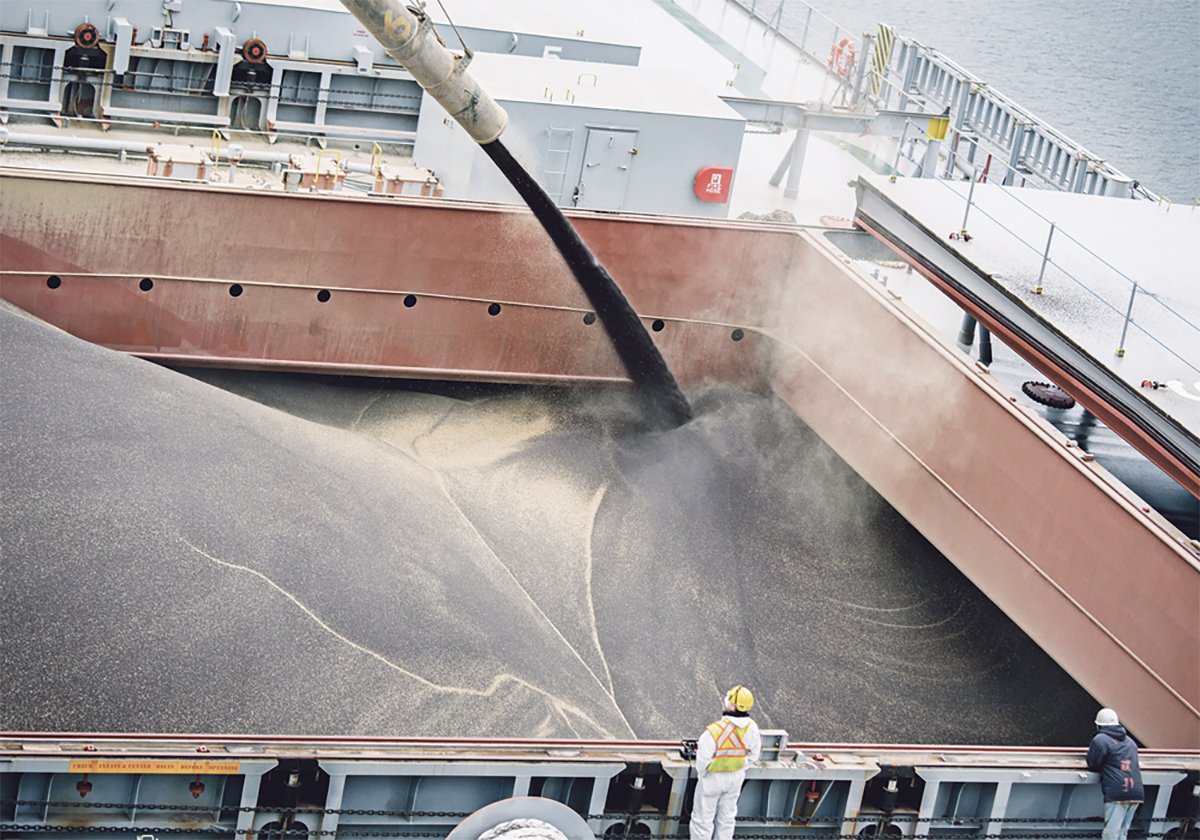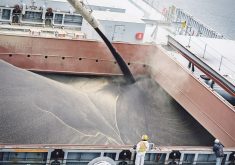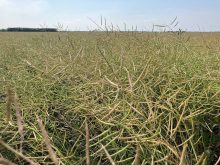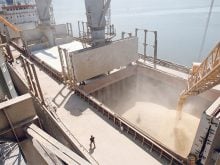The 300 megawatt, 230 kilovolt transmission line will pass within 36 metres of David Swanson’s house near Warner, Alta., and about the same distance from Diane Sincennes’ home near Coaldale, Alta.
The lines will run directly over Brad Moser’s irrigation dugout and along several edges of Wayne Van Giessen’s vegetable and row crop operation near Coaldale.
It will require a 14 kilometre relocation of a co-operative water line in the Warner area that co-op member Ed Sloboda said serves 54 customers.
Read Also

Exports off to a slow start after last year’s torrid pace
Canadian grain, oilseed and pulse exports are off to a slow start, but there are some bright spots, according to the Canadian Grain Commission’s most recent weekly export data report.
And the poles and lines will require some farmers to alter their irrigation pivot systems, while also affecting aerial and ground spraying operations.
These are some of the issues surrounding construction of the Montana Alberta Tie Ltd. (MATL) electrical transmission line that will run 345 km from just north of Lethbridge to just north of Great Falls, Montana.
MATL is a private company owned by Tonbridge Power Inc., based in Toronto.
The $209 million power line project was initiated six years ago and will affect 113 landowners between Lethbridge and the U.S. border. Proposed completion dates have been extended several times and the MATL website says the line will be in service in mid-2011.
But Daryl Bennett, a land agent with My Landman Group, who is representing 35 landowners in negotiations with MATL, hopes it can be delayed much longer.
He initiated a judicial review into whether the Alberta Surface Rights Board (ASRB), which authorizes rights of entry, used improper procedure in allowing MATL to access his clients’ land.
A ruling is expected any day and if the judge agrees with Bennett and his clients, Bennett said public hearings would have to be held so landowners can voice objections. That could potentially delay the project for years.
“We’ve asked the judge to rule that the (surface rights) board acted without due process and without following the principles of natural justice,” said Bennett.
“Hopefully he will send it back to the board, tell them to do it properly. Hopefully he’ll suspend the right of entry until they do that.”
MATL has been granted rights of entry to continue its project and numerous poles have already been erected, but construction is on hiatus for the spring thaw, said MATL regulatory consultant Bob Williams. He declined to comment on possible outcomes of the judicial review.
“I won’t speculate about the impact of a decision that may or may not be made. We’ll deal with any specific decisions when they happen and how they happen,” said Williams.
The judicial review is only the latest volley in landowners’ battles with MATL and what they consider to be the company’s unwillingness to negotiate on access and compensation.
MATL will pay an annual fee of $180 per pole erected on dry land and $250 per pole on irrigated land. There are also one-time payments for easement and compensation for any crop damage incurred during construction, Williams said.
However, landowners feel more money is warranted in some circumstances. There are also intangible effects from the power line that are difficult to measure and thus difficult to present to the surface rights board, which will decide on any further compensation.
“They (MATL) were supposed to look at each landowner’s circumstances,” said Bennett.
“All those pole figures should be different. Someone on potatoes should have a higher figure than someone on alfalfa, (who) farms around the pole maybe two or three times a year, where the potato farmer might farm around it 20 times per year.”
Bennett said the tangible portion of compensation can be calculated, such as farming inconvenience, costs associated with seed and spray overlap, extra wear on equipment and extra fuel and labour. However, those kinds of calculations are not possible for factors such as interference with GPS and cellphones, noise from the lines, sleep loss and potential health effects.
“The tangible portion we can quantify, but everybody – the National Energy Board, the Alberta Utilities Commission, even the Surface Rights Board – has acknowledged that those intangible adverse effects exist, a loss exists, but if we can’t quantify it, we don’t get compensation for it.”
Williams said negotiations with landowners have been difficult in some cases, but MATL remains willing to meet with landowners to discuss their concerns and devise solutions. He said in the six years of the project, the company has held open houses, offered to meet with each landowner along the route and created two community advisory committees, one on each side of the border.
“So, over the project, we’ve had a number of different ways to talk about the project, to listen to concerns and discuss reasonable solutions.”
That isn’t the perspective of several landowners affected.
“They don’t address the concerns whatsoever,” said Moser, a third generation farmer. “They have no intention of addressing the concerns.”
The power line will border 50 percent of Moser’s section of land, and he said the poles would hinder aerial spraying and affect his ability to maintain a dugout he uses for irrigation.
“The lines go right over my dugout. They basically told me I could clean it from the other side, that it would have no impact on my operation. I don’t feel that’s appropriate because someone’s life is in danger (while using a high hoe to clean the dugout), but they just refuse to deal with the issue.
“They were supposed to mitigate the impacts of the line, and compensation was second. Well, this company has no intention of mitigating any impacts that I have.”
Van Giessen, who also farms four quarters, said lack of opportunity for input into the line is one of his biggest concerns. It will run along the west side of his property, over farm buildings and beside a feedlot that he fears he may no longer be able to rent.
Van Giessen said the provincial government has failed to defend landowners’ property rights.
“Basically we don’t have any say on the whole affair,” he said. “We never got input, never. They just waltz in and say, ‘we’re going to need this land.’ We’ve never had a fair hearing because it was all predetermined.”
He said the process of determining compensation beyond easement and pole fees, which will be done after the line is erected, is flawed and puts unfair onus on landowners to prove losses.
“We do not get any compensation until after the fact, and that’s not right. If you buy a piece of land, you don’t say, ‘I’m going to farm first for a year and I’ll say what I think of it later.’ No, you first make the deal.”
Van Giessen, a dual citizen who immigrated to Canada about 30 years ago, said he now wonders about that decision.
“I told my boys, quite frankly, I wouldn’t stay in Canada. If I had to hand in a passport, it would be the Canadian passport. I have not seen any country in the free world where this takes place. It is worse than people can imagine.”
Sincennes, who farms 3.5 sections with her husband, said she is worried about how the line may affect the health of her two children.
“I’m supposed to take MATL’s word that there’s no risk?” she said.
“If they would have really been forthright and willing to work with landowners, a lot could have been done. They didn’t want to.”
As of last week, she said she still doesn’t know where the poles will be placed on their land.
“They haven’t told us where the poles are going to go, so I don’t know how many. We haven’t got that far with negotiations with them.”
Williams said all pole locations have been determined, but he has heard that some landowners say they don’t have that information.
“That doesn’t match with my understanding,” he said.
“We know the location of the poles as designed and our land agents have the information. If the landowners want to know that, we’re more than happy to sit down with them and go over the plan and show them where the poles will be located on their land.”
He said some landowners have refused to meet with MATL or its representatives.
Swanson is another farmer concerned about proximity of the line to his home. He objected to having power poles within 50 metres of the house and requested a review and variance of permit, with no result.
“We’ve requested that they jog away from our house and they’ve said they can’t do that, said they can’t afford to do that. Said it would be too costly and it would delay the project too much,” he said.
“They never offered us any compensation of any kind. Nothing. I don’t want to move my house. My house is in the right spot. It’s the power line that’s not in the right spot.”
Swanson said MATL’s engineers admitted the power line was too close to the residence, but no changes were made.
Williams said the power line route is difficult to alter this late in the construction process.
The original route was altered to avoid going over the environmentally sensitive Milk River ridge, and other minor changes have been approved by the Energy Utilities Board.
“The centre line has been set and at this point in the project, we’ve got all the materials delivered to our storage yards, so the design is done now,” he said.
“At this point in the project, there’s very little flexibility left to make further changes.”
Poles can be moved laterally along the centre line to accommodate some landowner requests, he added, and the height of the wires was increased to mitigate problems, but there will be no major route changes.
Swanson doesn’t agree with the explanation.
“If you interview MATL and they say it has to be on this route, it’s nonsense, because they have moved it in cases where it suits them.”
Job creation is another bone of contention.
MATL’s use of an American construction crew for some of its work in Alberta raised questions among landowners, some of whom said the company’s original application included promises of Alberta jobs.
However, Bennett said MATL received $160 million in stimulus funding from the U.S. government, which likely came with the proviso that work go to Americans.
Williams said MATL has created jobs in Canada, although the company made no specific promises in that regard.
“What we did say is that this project would provide a number of direct and indirect benefits and that’s exactly what we’ve done.”
He said MATL’s head office is in Calgary, the company has used Alberta survey companies and land agents, and jobs will be created for ongoing operations once the line is functional.
MATL is a private company and the line’s users will pay for its costs.
Williams said all but 50 megawatts of capacity have been awarded to wind energy companies building large projects in Montana.
“When the wind is blowing in that part of the state, as it often does, you’ll have renewable energy being delivered both into Lethbridge and into Great Falls.”
Williams said the line will enable development of 550 to 600 megawatts of wind energy through projects that would not otherwise proceed.
“Our transmission line connects the existing transmission grids in Alberta and Montana together directly for the first time. Every other province in Canada that borders on the United States has had transmission tie lines, at least one, for decades. So Alberta was unusual in that it didn’t have that.”
Despite issues with MATL negotiations and compensation, the landowners said they are not against the power line.
“MATL probably thinks we’re just trying to stall this, and there is an element, to some degree. We want to be treated fairly,” said Bennett.
Added Moser: “I just really want to stress that I’m not against power lines. What I’m against is their dealings with me, their refusal to negotiate, their refusal to mitigate some of the impacts that I’m going to have.”
Even Van Giessen, who is reconsidering his Canadian citizenship, said the line itself is not the problem.
“I am not against progress. If they need it, let them have it. Just give me fair compensation, and compensate before the action takes place. If they’d been fair from the start, the line could have been up and going already.”
Through it all is the lingering question of whether landowners will be compensated for intangible effects from the line.
“Right now, MATL doesn’t know how much they’re going to have to pay landowners, and landowners don’t know how much they’re going to get paid,” said Swanson.
“That might seem crazy to you, but that is the truth.”















